Sphingini tribe:
 |
Ceratomia amyntor WO, Elm Sphinx, Four-horned Sphinx:
Elm (Ulmus), birch (Betula), basswood (Tilia), cherry (Prunus).
There are both green and brown forms. The four horns near the head are diagnostic.
|
 |
Ceratomia undulosa WO, Waved Sphinx:
Fraxinus, Ligustrum, Quercus, Crataegus, Chionanthus virginicus.
In the fifth instar, the spiracular ovals are decidedly red and the anal horn is off-white to pinkish laterally.
|
 |
Lapara bombycoides BAMONA, Northern Pine Sphinx: Without the anal horn and feeds on pines.
The long stripes and reddish brown afford great camouflage.
|
 |
Manduca quinquemaculatus WO, Five-spotted Hawkmoth:
Tomato Hornworms, black horn at the end of the abdomen. Larvae feed on potato, tobacco, tomato, and other plants in the nightshade family (Solanaceae).
|
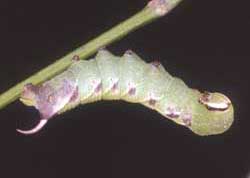
| Sphinx canadensis WO, Canadian Sphinx:
Uncommon, not often reported anywhere.
Larval hosts are white ash (Fraxinus americana) and blueberry (Vaccinium).
|
 |
Sphinx chersis WO, Northern Ash Sphinx, Great Ash Sphinx:
Pale bluish green. Head has pair of yellow lateral bands meeting at apex. Oblique, lateral stripes pale, bordered anteriorly with darker green.
Larval hosts are ash, lilac, privet, cherry, and quaking aspen.
|
 |
Sphinx drupiferarum WO, Wild Cherry Sphinx:
Larvae hide by day, feed primarily on cherry, plum, apple at night. Amelanchier nantuckensis
in Massachusetts, Michigan on Prunus serotina. Note purple oblique lines.
|
 |
Sphinx gordius WO, Apple Sphinx:
Apple (Malus), sweetfern (Myrica),
Carolina rose (Rosa carolina), blueberry and huckleberry
(Vaccinium), white spruce (Picea glauca), American
larch (Larix laricina), alder (Alnus).
|
 |
Sphinx kalmiae WO, Laurel Sphinx:
In the final instar, the black on the head, lateral lines, horn and on abdominal
legs is diagnostic. Larvae feed primarily on lilac and fringe.
|
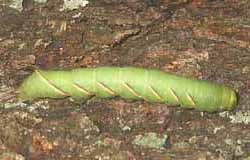 |
Sphinx luscitiosa WO, Canadian Sphinx, Clemen's Sphinx:
Willow (Salix), poplar (Populus), birch (Betula),
apple (Malus), ash (Fraxinus), waxmyrtle (Morella), northern bayberry.
|
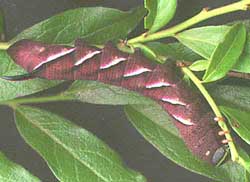 |
Sphinx poecila WO, Poecila Sphinx:
If you have blueberries in the woods, then you probably have the Poecila Sphinx. They are probably widespread throughout Wisconsin, but are very much under reported.
|
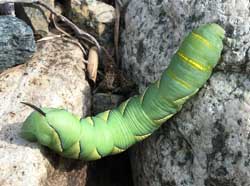 |
Sphinx vashti WO, Snowberry Sphinx: Common snowberry (Symphoricarpos albus)
coralberry (S. orbiculatus). Note two golden lines of slightly raised bumps, one just behind head, other on thorax.
|
Smerinthini Tribe:
 |
Amorpha juglandis WO, Walnut Sphinx:
Walnut and butternut (Juglans), hickory (Carya), alder (Alnus), beech (Fagus),
hazelnut (Corylus), hop-hornbeam (Ostrya). |
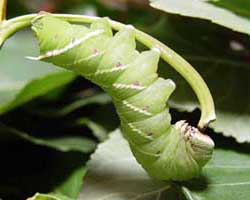 |
Pachysphinx occidentalis WO, Big Poplar Sphinx:
Cottonwood and poplar (Populus) and willow (Salix).
Longer horn distinguishes them from Pachysphinx modesta.
|
The listing by BAMONA of Pachysphinx occidentalis in Wisconsin (nearby counties) is a surprise as it is generally considered to be a much more western
species, not beginning to appear until the Dakotas.
 |
Paonias excaecata WO, Blinded Sphinx:
Larvae accept willows, birches, and cherries. I have also found them in the wild on oak in eastern Canada.
generally more eastern species
|
 |
Paonias myops WO, Small-eyed Sphinx:
Wild cherry species are the favorites as larval foodplants, but eggs will also be deposited on birches and other forest trees.
There are varying degrees in the amount of red markings along the sides.
|
 |
Smerinthus cerisyi WO, Cerisy's Sphinx;
Pale green, granular skin, pale lateral diagonal lines, faint red
spiracular circles, very pale longitudinal lines running from head to more pronounced anal diagonal line.
Green heads bounded dorsally with pale yellow inverted V.
|
 |
Smerinthus jamaicensis WO, Twin-spotted Sphinx:
Birches and cherries, expecially fond of poplars and willows. Red markings on sides vary greatly from specimen to specimen.
|
Macroglossinae subfamily
Dilophonotini Tribe:
See Hemaris comparison to help distinguish the next three species.
 |
Hemaris diffinis WO, Snowberry Clearwing:
Snowberry (Symphoricarpos), honeysuckle (Lonicera), Coralberry, viburnums, Blue Dogbane
(Apocynum), dwarf bush honeysuckle (Diervilla lonicera). Horn black, yellow base.
|
Hemaris diffinis larva, Osceola, Faith Gustafson.
 |
Hemaris gracilis WO, Slender Clearwing, Graceful Clearwing:
Blueberries, low bush blueberry (Vaccinium vacillans), laurel (Kalmia), in heath family (Ericaceae).
|
 |
Hemaris thysbe WO, Hummingbird Clearwing:
Orangey-pink prepupal form. Lateral line runs from S1 to blue horn.
Viburnum and related plants. generally more eastern species
|
Philampelini Tribe:
 |
Eumorpha achemon WO, Achemon Sphinx:
Grape (Vitis), Virginia Creeper (Parthenocissus quinquefolia), other vines, ivies (Ampelopsis).
Both light (green) form and darker (tan/brown) form. Note six "segmented" oblique lines. unlikely
|
 |
Eumorpha pandorus WO, Pandorus Sphinx:
If you have Grape or Virginia Creeper nearby, then you might encounter
pandorus. Note five large white ovals. Orangey-brown and green forms also.
unlikely |
Macroglossini Tribe:
 |
Amphion floridensis WO, Nessus Sphinix:
Virginia creeper, Grape (Vitis), ampelopsis (Ampelopsis), and cayenne pepper (Capsicum).
Larvae are green until the final instar.
|
 |
Darapsa choerilus WO, Azalea Sphinx:
Azalea, Viburnum, progress very rapidly. Larva, left, on Viburnum cassinoides getting ready to
pupate. Color change from green to light burgundy-brown indicates imminent pupation.
|
 |
Darapsa myron WO, Virginia Creeper Sphinx, Grapevine Sphinx:
If you have foodplants indicated in common names, you probably have myron. Lower wings orange.
Virginia creeper (Parthenocissus quinquefolia), Grape (Vitis), Ampelopsis, Viburnum. |
 |
Deidamia inscriptum WO, Lettered Sphinx:
Grape (Vitis), ampelopsis (Ampelopsis), Virginia creeper (Parthenocissus).
The alternating yellow and greyish-green rings across the back distinguish this larva.
|
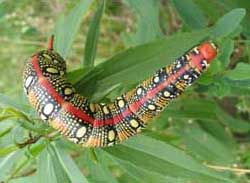 |
Hyles euphorbiae WO, Leafy Spurge Hawk Moth
Leafy spurge. Brightly colored, with pronounced "horn" near rear end. Young larvae variously patterned with green, yellow, black;
older larvae red, black, yellow, white color pattern. Mature larvae 10 cm in length; disturbed larvae regurgitate slimy green liquid.
|
 |
Hyles gallii WO, Bedstraw Hawk Moth, Gallium Sphinx:
Larvae come in black and in brown forms and often feed on Epilobium (fireweed).
|
 |
Hyles lineata WO, White-lined Sphinx:
Highly varied. Willow weed (Epilobium), four o'clock (Mirabilis),
apple (Malus), evening primrose (Oenothera), elm (Ulmus), grape (Vitis), tomato (Lycopersicon),
purslane (Portulaca), Fuschia. Red/black swellings split by dorso-lateral lines.
|

| Sphecodina abbottii WO, Abbott's Sphinx:
Feed at night on grape (Vitis), ampelopsis (Ampelopsis), hide on bark during day. Virginia creeper. Also a dark form
without green patches. Note "raised eye", replacing anal horn.
|
|

































